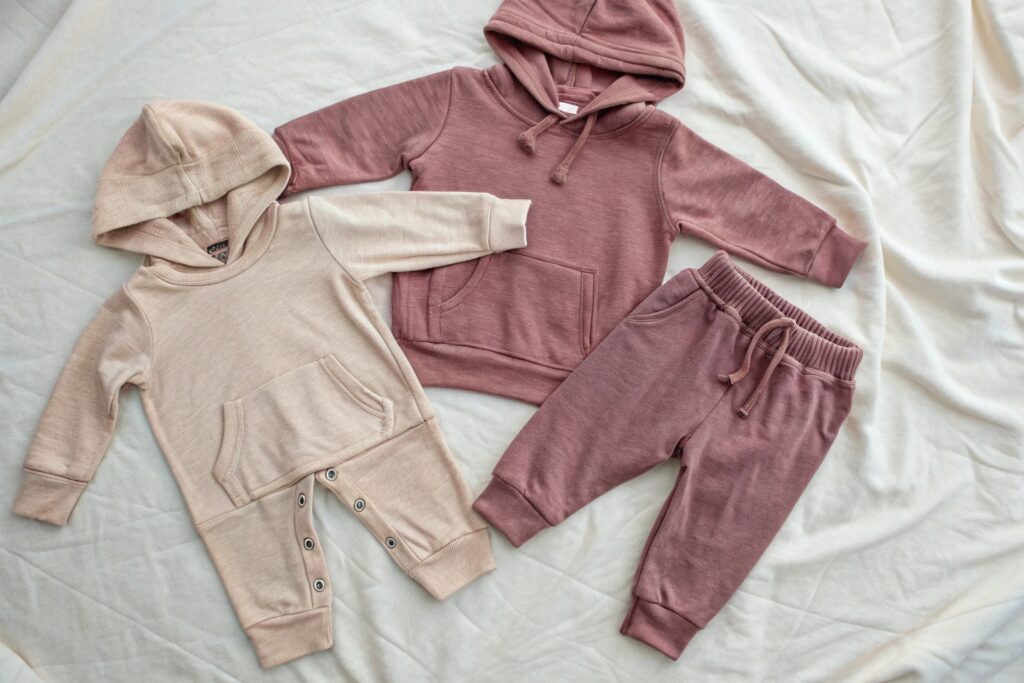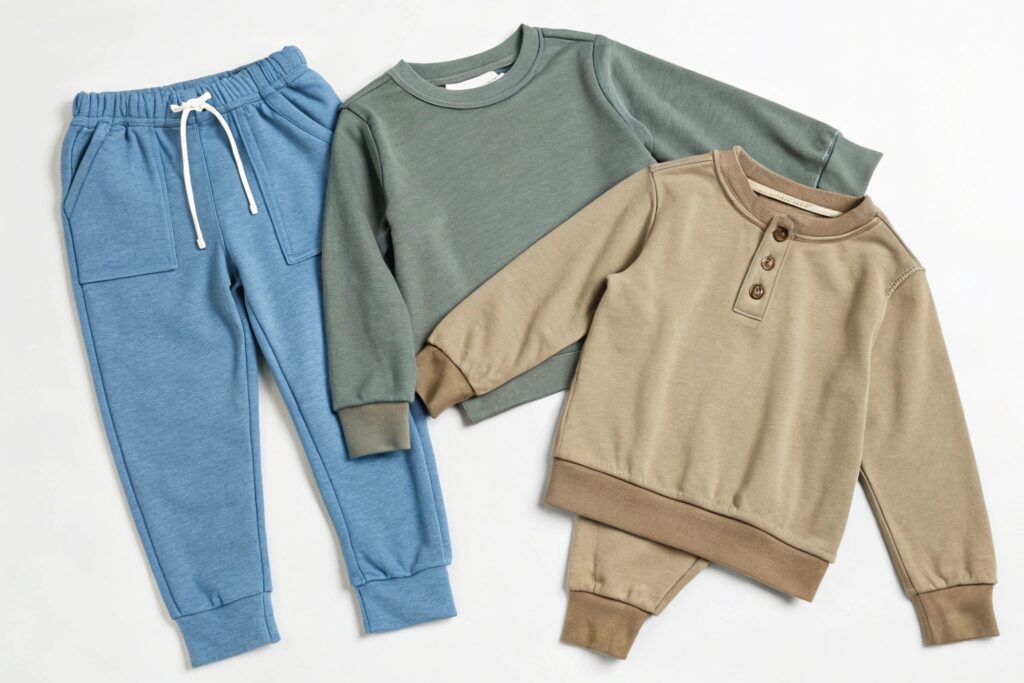Kids grow fast—and what works at age 2 won’t fly at age 10. But can one capsule logic adapt across all stages of childhood?
Yes. By adjusting key pieces, fabrics, and fit for different developmental stages, you can create age-appropriate capsules that grow with children.
I’ve worked with brands targeting every kidswear age bracket—from infant to tween—and the most successful lines understand that each age comes with its own comfort, mobility, and style needs. Here’s how to build smart capsules for every age.
Key Capsule Wardrobe Pieces by Age and Stage?
Children’s needs change dramatically between infancy and adolescence. And so should their capsule wardrobes.
Each age group requires capsule pieces that match their daily routines, motor development, and emerging sense of identity.

What Are the Ideal Capsule Items for Infants, Toddlers, Kids, and Pre-Teens?
Here’s a quick breakdown of recommended core items by age group:
| Age Group | Essential Capsule Pieces |
|---|---|
| 0–12 months | Bodysuits, footed sleepers, leggings, soft caps, onesies |
| 1–3 years | Pull-on pants, elastic tees, zip hoodies, rompers |
| 4–6 years | Tees, leggings, joggers, layering tunics, cardigans |
| 7–10 years | Graphic tees, denim or twill bottoms, hoodies, dresses |
| 11–13 years | Streetwear-style tops, stretch jeans, layering jackets |
Each capsule should reflect the lifestyle of that age. For babies, easy diaper access is crucial. For preschoolers, spill-friendly and easy-on clothing is key. For tweens, it’s about autonomy and trends.
We help our clients customize SKU bundles by age group, including developmentally appropriate closures (snaps, elastic waists, or buttons).
How Can Brands Design Capsules That Feel Personalized by Age?
One way is by adjusting visual themes and fit while keeping silhouettes consistent. A unisex tee, for instance, can be:
- Graphic-free and pastel for infants
- Patterned or illustrated for toddlers
- Graphic with slogans or icons for tweens
This way, your brand maintains product cohesion while appealing to different age-based preferences.
Capsule success depends on how well the product understands the child.
Toddler vs. Tween: How Capsule Needs Differ?
A capsule for a 2-year-old cannot be the same as one for an 11-year-old—and not just in size.
Toddlers need comfort and accessibility. Tweens need style and identity. Both require durability and mixability, but in very different ways.

What Are the Functional Priorities for Each Age Group?
We work with many brands designing for both toddlers and tweens. Here’s how we adjust capsule logic:
| Capsule Element | Toddler Need | Tween Need |
|---|---|---|
| Closures | Pull-on, snaps, no zippers | Zippers, buttons, fashion details |
| Fit | Roomy, stretch waistbands | Structured, trendy silhouettes |
| Fabric | Soft, organic cotton | Cotton blends, performance knits |
| Colors/Prints | Animals, primary colors | Abstract, text-based, muted tones |
| Style Identity | Parent-led choices | Peer-influenced autonomy |
We often build the toddler capsule around easy dressing. For tweens, we integrate layered pieces, hoodies, and subtle trend accents like puff sleeves or dropped shoulders.
This transition also reflects in production—using adjustable waists, removable hoods, or dual-function garments to add flexibility as the child grows.
How Can Brands Avoid Redesigning Entire Collections for Each Group?
The key is in modular design. Use shared base patterns, and adapt prints, fit, and finishes. For example:
- One jogger pattern, four finishes: fleece for toddlers, ribbed for tweens.
- One tee silhouette, three fits: boxy, standard, and slim.
This lets you scale while minimizing development time and inventory risks.
Capsule design is about smart variation—not complete reinvention.
Age-Appropriate Fabric and Fit Choices for Kids Capsules?
The same fabric won’t feel the same to a baby and a tween. And neither will fit.
Age-appropriate capsules use materials and silhouettes that support mobility, comfort, and body confidence across childhood development.

What Fabric Features Matter Most at Different Ages?
Here’s how we recommend adjusting fabric choices by age range:
| Age Range | Key Fabric Traits | Common Picks |
|---|---|---|
| 0–2 yrs | Soft, stretchable, breathable | Organic cotton, modal, bamboo blends |
| 3–6 yrs | Durable, stain-resistant, easy-care | Cotton-spandex, poly-cotton interlock |
| 7–10 yrs | Flexible, shape-retaining, structured | French terry, denim blends, rib knits |
| 11–13 yrs | Trendy, textured, moisture-managing | Modal-spandex, pique, performance jersey |
We help clients run wash-cycle tests for each age group’s core items to ensure fabrics perform. For younger kids, shrinkage is a top concern. For older kids, color fading and pilling come up more.
How Does Fit Evolve Across Age Groups?
Fit shifts from comfort-led to style-led:
- Infants need loose fit and full coverage.
- Toddlers require movement-friendly fits.
- School-age kids benefit from slimmer, layered fits.
- Tweens want fashion-aligned fits—cropped, oversized, or tapered.
We build custom fit blocks for clients based on age segmentation. This supports everything from leggings with longer rise for toddlers to slim-fit joggers for tweens.
Fit isn’t just about size—it’s about identity, confidence, and how clothes feel in motion.
Building Scalable Capsules from Infant to Pre-Teen?
Designing across ages doesn’t mean you need dozens of SKUs. A smart capsule can scale smoothly.
Scalable capsules share silhouettes, fabrics, and design logic—adjusted subtly across age brackets to reduce production complexity and increase brand cohesion.

What Design Elements Help Scale Capsules Across Age Ranges?
These design strategies allow brands to expand a capsule line with control:
- Unified color story – E.g., muted seasonal palette across all ages
- Shared silhouettes – Tunics, joggers, tees reinterpreted by stage
- Modular layers – Cardigans or hoodies that evolve in texture or shape
- Consistent trims – Using the same buttons, labels, or print styles
One of our clients developed a “Grow with You” line using the same base pattern across 3 age brackets. They altered only sleeve length, fabric weight, and waist adjustability.
The result: fewer prototypes, faster production, and clearer brand identity.
How Can You Organize Age-Bracketed Capsules for Buyers?
We suggest packaging capsules into segmented pre-packs:
| Age Bracket | Pack Example (5–7 Pieces) |
|---|---|
| 0–2 yrs | Bodysuits, rompers, footed leggings, hoodie |
| 3–6 yrs | T-shirts, pull-on pants, tunic, zip-up hoodie |
| 7–10 yrs | Graphic tees, stretch denim, layering cardigan |
| 11–13 yrs | Trendy tops, joggers, shackets, streetwear hoodie |
We also help clients prepare lookbooks sorted by age, allowing retail buyers or parents to shop age-appropriate sets with ease.
Capsule success is in the planning—and a well-scaled capsule builds brand loyalty from baby to tween.
Conclusion
Kids change, and so should their clothes. But capsule logic still works at every age when adapted with the right materials, fit, and function. At Fumao Clothing, we help brands design age-smart capsule collections that grow with every stage of childhood.










